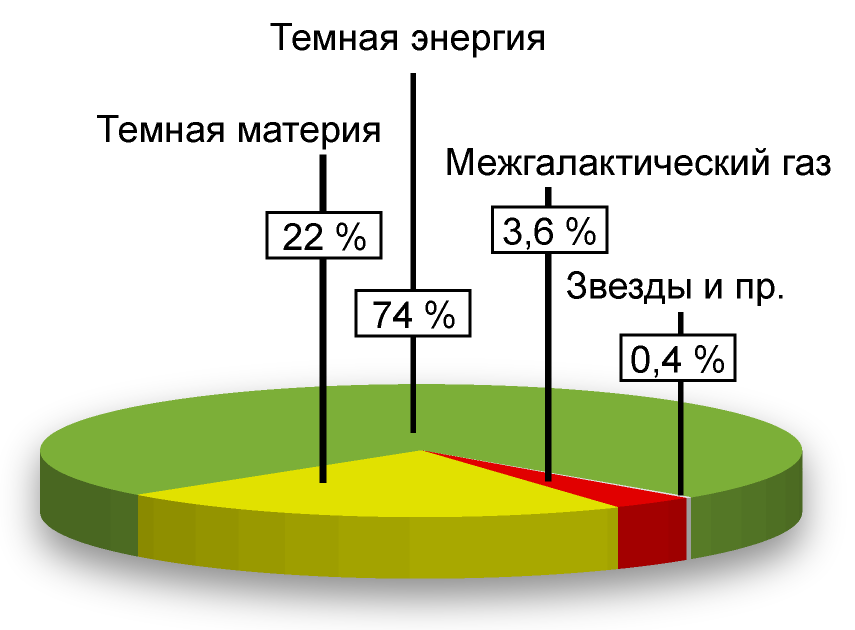
Dark matter. Six cosmological problems
The movements of objects on a cosmic scale obey the good old Newton's theory. However, the discovery of Fritz Zwicky in the 30s and subsequent numerous observations of distant galaxies that rotate faster than their apparent mass would indicate, prompted astronomers and physicists to calculate the mass of dark matter, which cannot be determined directly in any available range of observation. to our tools. The bill turned out to be very high - it is now estimated that almost 27% of the mass of the universe is dark matter. This is more than five times more than the "ordinary" matter available to our observations.
Unfortunately, elementary particles do not seem to foresee the existence of particles that would make up this enigmatic mass. Until now, we have not been able to detect them or generate high-energy beams in colliding accelerators. The last hope of scientists was the discovery of "sterile" neutrinos, which could make up dark matter. However, so far attempts to detect them have also been unsuccessful.
Dark energy
Since it was discovered in the 90s that the expansion of the universe is not constant, but accelerating, another addition to the calculations was required, this time with energy in the universe. It turned out that to explain this acceleration, additional energy (i.e. masses, because according to the special theory of relativity they are the same) - i.e. dark energy - should make up about 68% of the universe.
That would mean that more than two-thirds of the universe is made up of... god knows what! Because, as in the case of dark matter, we have not been able to capture or explore its nature. Some believe that this is the energy of the vacuum, the same energy at which particles "out of nothing" appear as a result of quantum effects. Others suggest that it is the "quintessence", the fifth force of nature.
There is also a hypothesis that the cosmological principle does not work at all, the Universe is inhomogeneous, has different densities in different areas, and these fluctuations create the illusion of accelerating expansion. In this version, the problem of dark energy would be just an illusion.
Einstein introduced into his theories - and then removed - the concept cosmological constantassociated with dark energy. The concept was continued by quantum mechanics theorists who tried to replace the notion of the cosmological constant quantum vacuum field energy. However, this theory gave 10120 more energy than is needed to expand the universe at the rate we know...
inflation
Theory space inflation it explains a lot satisfactorily, but introduces a small (well, not for everyone small) problem - it suggests that in the early period of its existence, its expansion rate was faster than the speed of light. This would explain the currently visible structure of space objects, their temperature, energy, etc. The point, however, is that no traces of this ancient event have been found so far.
Researchers at Imperial College London, London and the Universities of Helsinki and Copenhagen described in 2014 in Physical Review Letters how gravity provided the stability needed for the universe to experience severe inflation early in its development. The team analyzed interaction between Higgs particles and gravity. Scientists have shown that even a small interaction of this type can stabilize the universe and save it from catastrophe.
Graph of the rotation speed of the spiral galaxy M33
“The standard model of elementary particle physics, which scientists use to explain the nature of elementary particles and their interactions, has not yet answered the question of why the Universe did not collapse immediately after the Big Bang,” said the professor. Artu Rajanti from the Physics Department of Imperial College. “In our study, we focused on the unknown parameter of the Standard Model, that is, the interaction between Higgs particles and gravity. This parameter cannot be measured in particle accelerator experiments, but it has a strong influence on the instability of Higgs particles during the inflation phase. Even a small value of this parameter is enough to explain the survival rate.”
A web of dark matter illuminated by a quasar
Some scholars believe that inflation, once it starts, is difficult to stop. They conclude that its consequence was the creation of new universes, physically separated from ours. And this process will continue until today. The multiverse is still spawning new universes in an inflationary rush.
Returning to the constant speed of light principle, some inflation theorists suggest that the speed of light is, yes, a strict limit, but not a constant. In the early era it was higher, allowing for inflation. Now it continues to fall, but so slowly that we are unable to notice it.
Combining Interactions
The current balance of ordinary matter, dark matter and dark energy
The Standard Model, while unifying the three types of forces of nature, does not unify the weak and strong interactions to the satisfaction of all scientists. Gravity stands aside and cannot yet be included in the general model with the world of elementary particles. Any attempt to reconcile gravity with quantum mechanics introduces so much infinity into the calculations that the equations lose their value.
quantum theory of gravity requires a break in the connection between the gravitational mass and the inertial mass, known from the principle of equivalence (see the article: "Six Principles of the Universe"). Violation of this principle undermines the building of modern physics. Thus, such a theory, which opens the way to a theory of dreams about everything, can also destroy the physics known so far.
Although gravity is too weak to be noticeable on the small scales of quantum interactions, there is a place where it becomes strong enough to make a difference in the mechanics of quantum phenomena. This black holes. However, the phenomena occurring inside and on their outskirts are still little studied and studied.
Setting up the universe
The Standard Model cannot predict the magnitude of the forces and masses that arise in the world of particles. We learn about these quantities by measuring and adding data to the theory. Scientists are constantly discovering that just a small difference in measured values is enough to make the universe look completely different.
For example, it has the smallest mass needed to support the stable matter of everything we know. The amount of dark matter and energy is carefully balanced to form galaxies.
One of the most puzzling problems with tuning the parameters of the universe is the advantage of matter over antimatterwhich allows everything to exist stably. According to the Standard Model, the same amount of matter and antimatter should be produced. Of course, from our point of view, it is good that matter has an advantage, since equal amounts imply the instability of the Universe, shaken by violent outbursts of annihilation of both types of matter.
Visualization of the multiverse with expanding and contracting universes
Measurement problem
Solution dimension quantum objects means the collapse of the wave function, i.e. "change" of their state from two (Schrödinger's cat in an indeterminate state of "alive or dead") to a single one (we know what happened to the cat).
One of the bolder hypotheses related to the problem of measurement is the concept of "many worlds" - the possibilities from which we choose when measuring. The worlds are separating every moment. So, we have a world in which we look into a box with a cat, and a world in which we do not look into a box with a cat ... In the first - the world in which the cat lives, or the one in which he does not live, etc. d.
he believed that something was deeply wrong with quantum mechanics, and his opinion was not to be taken lightly.
Four main interactions

